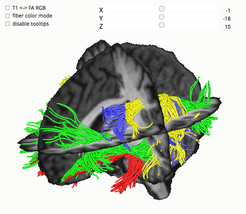The current Model
The brain basis of language processing: From structure to function

Knowledge about the neural basis of the human language faculty has increased considerably over the past years. The data available in the literature and from our own studies are reviewed in a recent paper (Friederici, 2011, Physiol Rev, 91, 1357-1392). Structural and functional brain imaging of this publication in Physiological Reviews are available in a 3-D online version. Based on this, we propose a model which assumes fronto-temporal networks supporting different syntactic and semantic aspects during language comprehension.
Initial acoustic-phonological processes take place during the first hundred milliseconds after acoustic stimulation and crucially involve the primary auditory cortex (PAC) and the planum temporale (PT). From these regions, the information is transferred both to the anterior and the posterior parts of the superior temporal gyrus (STG) and sulcus (STS). The left anterior STG, together with the left frontal operculum, which is connected via a ventral pathway through the uncinate fasciculus (Ventral Pathway II, see Fig. 1), builds the neural network for initial local phrase structure building processes. Then semantic, grammatical and thematic relations in a sentence are processed in parallel systems, activating separable left-lateralized temporo-frontal networks. The semantic network involves the middle and posterior STG/MTG (sometimes extending into anterior temporal regions) and BA 45/47 in the inferior frontal cortex connected via the extreme capsule fibre system (Ventral Pathway I, see Fig. 1).

For the processing of syntactically complex sentences, a network is proposed which consists of Broca’s area (in particular, the pars opercularis, BA 44) and the posterior temporal cortex (pSTG/STS) connected via the arcuate fascile/superior longitudinal fascile (Dorsal Pathway II). Neuroanatomical findings, moreover, suggest a dorsal pathway connecting the posterior temporal cortex to the premotor cortex (Dorsal Pathway I), supposedly supporting sensory-to-motor mappings. These two dorsal streams may have different functions, with the former subserving top-down processes and the latter supporting bottom-up processes, making rule-based and possibly context-based predictions about the incoming information. Suprasegmental prosodic information is predominantly processed by the right hemisphere. The interaction of syntactic information processed in the left hemisphere and prosodic information processed in the right hemisphere is supported by the posterior portion of the corpus callosum, the structure which connects the temporal cortices of the two hemispheres.
This model serves as a conceptual basis and research agenda for much of the work in the Department of Neuropsychology, both in the Neurocognition of Language Processing Group and as an adult template for the developmental work in the Neurocognition of Language Learning Group.

